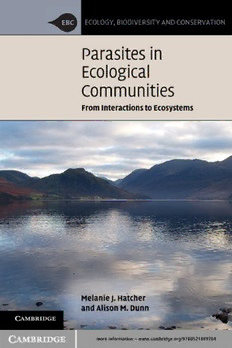
Parasites in ecological communities: from interactions to ecosystems PDF
Preview Parasites in ecological communities: from interactions to ecosystems
This page intentionally left blank Parasites in Ecological Communities From Interactions to Ecosystems Interactions between competitors, predators and their prey have traditionally beenviewedasthefoundationofcommunitystructure.Parasites–longignored in community ecology – are now recognised as playing an important part in influencingspeciesinteractionsandconsequentlyaffectingecosystemfunction. Parasitism can interact with other ecologicaldrivers,resultinginboth detri- mental and beneficial effects on biodiversity and ecosystem health. Species interactions involving parasites are also key to understanding many biological invasionsandemerginginfectiousdiseases.Thisbookbridgesthegapbetween communityecologyandepidemiologytocreateawide-rangingexaminationof howparasitesandpathogensaffectallaspectsofecologicalcommunities,enab- lingthenewgenerationofecologiststoincludeparasitesasakeyconsideration in their studies. This comprehensive guide to a newly emerging field is of relevance to academics, practitioners and graduates in biodiversity, conservation and popu- lation management, and animaland humanhealth. melanie j. hatcher isVisitingResearchFellow,SchoolofBiology,Univer- sity of Bristol, UK, and Senior Research Fellow, Institute of Integrative and ComparativeBiology, University of Leeds,UK. alison m. dunn is Reader in Evolutionary Ecology, Institute of Integrative and Comparative Biology, Faculty of Biological Sciences, University of Leeds, UK. ecology, biodiversityand conservation SeriesEditors MichaelUsher UniversityofStirling,andformerlyScottishNaturalHeritage DenisSaunders FormerlyCSIRODivisionofSustainableEcosystems,Canberra RobertPeet UniversityofNorthCarolina,ChapelHill AndrewDobson PrincetonUniversity EditorialBoard PaulAdam UniversityofNewSouthWales,Australia H.J.B.Birks UniversityofBergen,Norway LenaGustafsson SwedishUniversityofAgriculturalScience JeffMcNeely InternationalUnionfortheConservationofNature R.T.Paine UniversityofWashington DavidRichardson UniversityofCapeTown JeremyWilson RoyalSocietyfortheProtectionofBirds Theworld’sbiologicaldiversityfacesunprecedentedthreats.Theurgentchallengefacing the concerned biologist is to understand ecological processes well enough to maintain theirfunctioninginthefaceofthepressuresresultingfromhumanpopulationgrowth. Those concerned with the conservation of biodiversity and with restoration also need to be acquainted with the political, social, historical, economic and legal frameworks within which ecological and conservation practice must be developed. The new Ecology,BiodiversityandConservationserieswillpresentbalanced,comprehensive,up-to- dateandcriticalreviewsofselectedtopicswithinthesciencesofecologyandconservation biology, both botanical and zoological, and both ‘pure’ and ‘applied’. It is aimed at advancedfinal-yearundergraduates,graduatestudents,researchersanduniversityteach- ers,aswellasecologistsandconservationistsinindustry,governmentandthevoluntary sectors.Theseriesencompassesawiderangeofapproachesandscales(spatial,temporal andtaxonomic),includingquantitative,theoretical,population,community,ecosystem, landscape, historical, experimental, behavioural and evolutionary studies. The empha- sis is on science related to the real world of plants and animals rather than on purely theoretical abstractions and mathematical models. Books in this series will, wherever possible, consider issues from a broad perspective. Some books will challenge existing paradigms and present new ecological concepts, empirical or theoretical models and testablehypotheses.Otherbookswillexplorenewapproachesandpresentsyntheseson topicsofecologicalimportance. EcologyandControlofIntroducedPlants JudithH.MyersandDawnBazely InvertebrateConservationandAgriculturalEcosystems T.R.New RisksandDecisionsforConservationandEnvironmentalManagement MarkBurgman EcologyofPopulations EsaRanta,PerLundbergandVeijoKaitala NonequilibriumEcology KlausRohde TheEcologyofPhytoplankton C.S.Reynolds SystematicConservationPlanning ChrisMargulesandSahotraSarkar LargeScaleLandscapeExperiments:LessonsfromTumut DavidB.Lindenmayer AssessingtheConservationValueofFreshwaters:AnInternationalPerspective PhilipJ.BoonandCatherineM.Pringle InsectSpeciesConservation T.R.New BirdConservationandAgriculture JeremyD.Wilson,AndrewD.EvansandPhilipV.Grice CaveBiology:LifeinDarkness AldemaroRomero BiodiversityinEnvironmentalAssessment:EnhancingEcosystemServicesforHumanWell-being RoelSlootweg,AshaRajvanshi,VinodB.MathurandArendKolhoff MappingSpeciesDistributions:SpatialInferenceandPrediction JanetFranklin DeclineandRecoveryoftheIslandFox:ACaseStudyforPopulationRecovery TimothyJ.Coonan,CatherinA.SchwemmandDavidK.Garcelon EcosystemFunctioning KurtJax Spatio-TemporalHeterogeneity:ConceptsandAnalyses PierreR.L.Dutilleul Parasites in Ecological Communities From Interactions to Ecosystems MELANIE J. HATCHER UniversityofBristol,UK ALISON M. DUNN UniversityofLeeds,UK cambridgeuniversitypress Cambridge,NewYork,Melbourne,Madrid,CapeTown, Singapore,Sa˜oPaulo,Delhi,Tokyo,MexicoCity CambridgeUniversityPress TheEdinburghBuilding,CambridgeCB28RU,UK PublishedintheUnitedStatesofAmericabyCambridgeUniversityPress,NewYork www.cambridge.org Informationonthistitle:www.cambridge.org/9780521889704 #M.J.HatcherandA.M.Dunn2011 Thispublicationisincopyright.Subjecttostatutoryexception andtotheprovisionsofrelevantcollectivelicensingagreements, noreproductionofanypartmaytakeplacewithout thewrittenpermissionofCambridgeUniversityPress. Firstpublished2011 PrintedintheUnitedKingdomattheUniversityPress,Cambridge AcataloguerecordforthispublicationisavailablefromtheBritishLibrary LibraryofCongressCataloguing-in-Publicationdata Hatcher,MelanieJ. Parasitesinecologicalcommunities:frominteractionstoecosystems/Melanie J.Hatcher,AlisonM.Dunn. p. cm.– (Ecology,biodiversityandconservation) ISBN978-0-521-88970-4(Hardback)–ISBN978-0-521-71822-6(Paperback) 1. Parasites–Ecology. 2. Parasites–Behavior. 3. Host-parasiterelationships. 4. Parasitology. 5. Bioticcommunities. I. Dunn,AlisonM. II. Title. III. Series. QL757.H342011 577.8057–dc22 2010050212 ISBN978-0-521-88970-4Hardback ISBN978-0-521-71822-6Paperback CambridgeUniversityPresshasnoresponsibilityforthepersistenceor accuracyofURLsforexternalorthird-partyinternetwebsitesreferredto inthispublication,anddoesnotguaranteethatanycontentonsuch websitesis,orwillremain,accurateorappropriate. Contents Acknowledgements page xii List of abbreviations xiv 1 Introduction 1 1.1 Concepts from epidemiology 5 1.2 Concepts from community ecology 9 1.3 Parasites 12 1.4 Aims of this book 17 2 Parasites and competitors 20 2.1 Introduction 20 2.1.1 Parasitism in modules of competition 21 2.2 One-host–one-parasite systems 22 2.2.1 Population dynamics 23 2.2.2 Competitive release 30 2.3 Apparent competition 32 2.3.1 Baseline theory 32 2.3.2 Implications for biological control 37 2.3.3 Empirical evidence for apparent competition 39 2.4 Parasite-mediated competition 49 2.4.1 Specialist parasite-mediated competition 49 2.4.2 Shared parasite-mediated competition 50 2.5 Parasite-modified competition 56 2.6 Examples from conservation and management 59 2.6.1 Red squirrels, grey squirrels and poxvirus 59 2.6.2 Grey partridge, pheasants and nematodes 63 2.6.3 White-tailed deer, moose and brainworm 66 2.6.4 Red grouse, deer, mountain hare, sheep and louping ill virus 68 viii (cid:2) Contents 2.7 Competition between parasites 72 2.7.1 Competition for resources 77 2.7.2 Apparent and host-mediated competition 78 2.7.3 Coinfections and trait-mediated indirect effects 81 2.8 Conclusions 86 3 Parasites and predators 90 3.1 Introduction 90 3.1.1 Overview of predation modules 90 3.2 Parasites of prey with specialist predators 92 3.2.1 Baseline theory 92 3.2.2 Empirical examples 100 3.3 Parasites of prey with generalist predators 104 3.3.1 Baseline theory 104 3.3.2 Empirical examples 107 3.3.3 Evolutionary dynamics and predation 115 3.4 Parasites of predators 118 3.4.1 Baseline theory 118 3.4.2 Empirical examples 119 3.5 Parasites of predators and prey 123 3.5.1 Patterns and evolution of manipulation and trophic transmission 124 3.5.2 Theoretical impacts on populations and communities 126 3.6 Applications: predator control and harvesting 129 3.6.1 Do predators keep the herds healthy? 129 3.6.2 Biological control 133 3.6.3 Harvesting infected populations 135 3.7 Conclusions 138 4 Parasites and intraguild predation 141 4.1 Introduction 141 4.1.1 Parasitism and IGP 142 4.1.2 Predictions from basic IGP theory 143 4.2 Ecological significance of IGP 145 4.3 IGP as a unifying framework for competition and predation 149 4.4 Parasites intrinsic to IGP 151 4.4.1 IGP in trophic transmission 152 4.4.2 Parasites and IGP in biological control 155
